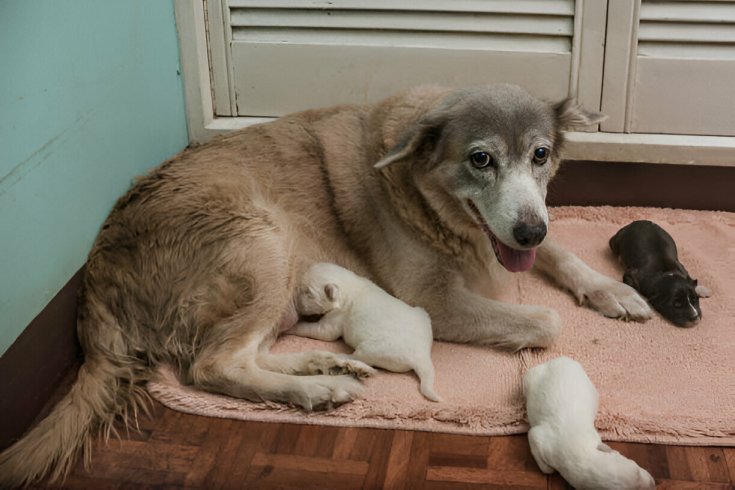Whelping Bitches – notes for owners
Is your Bitch about to Whelp?
These notes are designed to allow your bitch to have a trouble free whelping, and to help you understand the process.
If things do go wrong you are then better informed as to when to seek help. Contact us on 03-577-9822.
Length of Gestation
This is normally 63 days from ovulation.
As we rarely know exactly when ovulation has occurred, we thus hear many stories of gestation as short as 58 days, or as long as 67 or 68 days.
When longer than 63 days it means the mating took place prior to ovulation. Fresh healthy dog semen can live for about a week in the bitch.
When shorter than 63 days, the mating occurred after ovulation.
Around the time of mating we can get a very accurate time of ovulation by a simple blood test measuring progesterone. This may be very useful later on if there is a problem.
Indicators of Impending Birth
In the last few days your bitch may:
1. Become restless.
2. Exhibit occasional panting.
3. Build a nest.
4. Hide away under a house or some other private place.
5. Make milk.
All these are signs, but none give an accurate means of predicting whelping time.
Two methods can be used to predict the time within 24 hours.
1. Twice daily rectal temperature readings.
2. Blood progesterone levels.
Blood progesterone levels are used when there is no other available information. They are very accurate, but take us 24 hours to get an answer.
Rectal Temperature Readings
You will need to plot your bitch’s temperature on a chart.
Normal temperature is 37.5 – 38.5 centigrade.
12 – 24 hours prior to whelping this drops significantly, usually to 37.1 or lower. In small breeds this can be as low as 36.4
If you have a 12 hourly chart of morning and evening temperatures for the past 5 – 7 days it is very clear when this drop occurs.
Taking the Temperature
Remember if using a mercury thermometer to shake the thermometer well down below 36.5oC before you take the temperature.
Gently insert the thermometer into the dog’s rectum at least 2-3cm. Leave it in for at least 90 seconds.
Withdraw it, wipe it clean with a piece of cottonwool and read carefully. Note the reading down.
Enter it on your chart.
Do this at 7 or 8 am and 7 or 8 pm each day.
When the temperature drops below 37.2 (lower in small breeds – discuss with our vets) or there is a significant drop from the last several readings, ring the clinic and ask reception to inform the veterinarian who is handling your case.
We will get back to you and discuss the situation.
Labour
Signs of Impending Parturition (24 hours before whelping)
a. rectal temperature decreases by about 1 degree Celsius.
b. anorexia.
c. nesting behaviour:
Nesting may occur before this but will intensify in the 24 hours immediately preceding parturition.
d. mammary development and abdominal swelling are NOT good indicators of impending parturition, they vary considerably between bitches and with parity.
Stage 1 Labour
a. 6 – 12 hours duration.
b. cervical dilation occurs and uterine contractions begin but are not visible externally.
c. panting, restlessness, nervousness, anorexia, shivering, occasionally vomiting.
d. contractions are regular and of decreasing interval.
Stage 2 Labour
a. 3 – 12 hours duration (huge variation).
b. onset of straining, passage of pups and placental membranes.
c. the presence of pups stimulating nerves in the cervix and vagina causes abdominal contraction and the release of oxytocin.
d. 1st pup usually is born in 1 hour.
e. pup should be born every 2 hours or less.
f. bitch has ability to stop stage 2, especially if disturbed, and may resume after rest.
g. usually delivery alternates between uterine horns and the fullest horn goes first.
h. usually get pup, followed by placenta, followed by pup but this is not always the case.
i. 40% of pups are born in posterior presentation, which is NORMAL.
j. expect the bitch to clean the pup and eat the placenta immediately – this is normal although it is not necessary for the bitch to eat the placenta.
Stage 3 Labour
a. in other species stage 3 refers to the passage of the placentae, but in the bitch this is accomplished during stage 2.
Postpartum
a. a reddish-brown, possibly bloody vaginal discharge is normal for up to 7 days after parturition.
Problem Signs Before Whelping
1. Black or dark green discharge.
2. No pups more than 24 hours after major temperature drop.
3. Shaking/shivering for up to 24 hours.
4. Listless/inappetant for more than 24 hours.
5. Stage 2- Labour for 2 hours without pups.
Problem Signs During Whelping
1. Straining for more than 2 hours between pups.
2. Greater than 2 hour interval between pups, yet no straining. May indicate inertia of the uterus.
3. Pup stuck in vulva, head protruding but no progress.
Problem Signs After Whelping
1. Pups continually crying.
2. Pups losing or not gaining weight (or dying).
3. No milk when nipples are squeezed.
4. Hard, inflamed udder and/or smelly vaginal discharge.
5. Discoloured vaginal discharge greater than one week post whelping.
Caesarean Section
Occasionally, due to extra large pups, or one pup becoming stuck, or when there is uterine inertia, we have to perform a caesarean section.
This is a routine operation, but is always better in controlled daytime situations than in the middle of the night, short handed.
For that reason, prior warning of whelpings for us is always helpful.
In particular, temperature taking tells us when to expect things to happen.
Other really useful information is:
1. All mating dates.
2. Day of first signs of blood spotting prior to mating.
